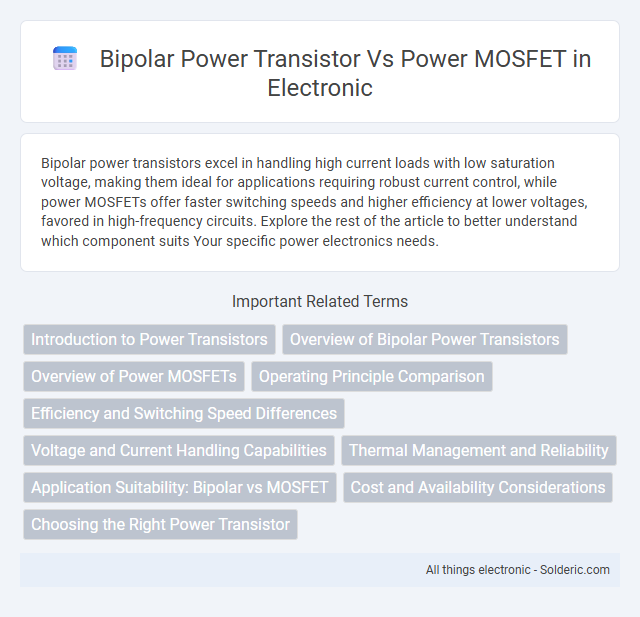Bipolar power transistors excel in handling high current loads with low saturation voltage, making them ideal for applications requiring robust current control, while power MOSFETs offer faster switching speeds and higher efficiency at lower voltages, favored in high-frequency circuits. Explore the rest of the article to better understand which component suits Your specific power electronics needs.
Comparison Table
| Feature | Bipolar Power Transistor (BJT) | Power MOSFET |
|---|---|---|
| Device Type | Current-controlled device | Voltage-controlled device |
| Input Impedance | Low input impedance | High input impedance |
| Switching Speed | Slower switching | Faster switching |
| Conduction Loss | Higher saturation voltage (V_CE(sat)) leading to higher losses | Lower on-resistance (R_DS(on)) reducing conduction losses |
| Drive Requirements | Requires continuous base current | Requires gate voltage, negligible gate current |
| Thermal Stability | Moderate thermal stability | Better thermal stability |
| Safe Operating Area (SOA) | Smaller SOA | Larger SOA |
| Applications | Linear amplifiers, high current switching | High frequency switching, PWM, DC-DC converters |
| Cost | Generally lower cost | Typically higher cost |
Introduction to Power Transistors
Power transistors, including Bipolar Junction Transistors (BJTs) and Power MOSFETs, are essential semiconductor devices designed to control and amplify high electrical power in applications like switching power supplies and motor drives. Bipolar power transistors operate using both electron and hole charge carriers, offering high gain and robustness in linear amplification, while Power MOSFETs utilize voltage-controlled channels to achieve faster switching speeds and higher efficiency at lower voltage levels. Selection between Bipolar power transistors and Power MOSFETs depends on factors such as switching frequency, conduction losses, and thermal performance requirements in specific power electronics designs.
Overview of Bipolar Power Transistors
Bipolar power transistors are semiconductor devices that control high voltage and current by utilizing both electron and hole charge carriers, making them suitable for high-power applications. Their ability to handle large currents with low saturation voltage leads to enhanced efficiency in power amplification and switching circuits. Your choice between bipolar power transistors and power MOSFETs should consider factors like switching speed, thermal stability, and linearity, where bipolar transistors excel in linear amplification and MOSFETs offer faster switching.
Overview of Power MOSFETs
Power MOSFETs are semiconductor devices widely used in power electronics for their high switching speed and efficient voltage control. Unlike bipolar power transistors, Power MOSFETs operate with majority carriers, resulting in lower on-resistance and reduced heat dissipation. Their voltage-driven gate enables easy interfacing with low-voltage digital circuits, making them ideal for applications requiring fast switching and high efficiency.
Operating Principle Comparison
Bipolar power transistors operate using both electron and hole charge carriers, relying on current control through the base terminal for switching and amplification. Power MOSFETs function based on voltage control, where an electric field modulates the conductivity of a semiconductor channel between the source and drain terminals. Your choice depends on factors like switching speed, efficiency, and thermal performance, with MOSFETs generally offering faster operation and lower gate drive power compared to bipolar transistors.
Efficiency and Switching Speed Differences
Power MOSFETs typically offer higher switching speeds and greater efficiency at low voltages due to their majority-carrier conduction channel, reducing switching losses and enabling faster transitions. Bipolar power transistors, relying on minority-carrier injection, exhibit higher conduction losses and slower switching speeds, which can result in decreased efficiency in high-frequency applications. In applications requiring high-speed switching and efficiency, power MOSFETs are generally preferred, whereas bipolar transistors may still be favorable in high-current, low-frequency scenarios.
Voltage and Current Handling Capabilities
Bipolar power transistors typically handle higher current densities, making them suitable for applications requiring large current flow, with voltage ratings commonly ranging up to 1000 volts. Power MOSFETs offer superior voltage handling capabilities, often exceeding 500 volts, and exhibit low on-resistance, which reduces power dissipation during high current conduction. The choice between Bipolar power transistors and Power MOSFETs depends on the specific voltage and current requirements, where MOSFETs excel in high-voltage low-current applications, while Bipolar transistors perform better in high-current low-voltage scenarios.
Thermal Management and Reliability
Bipolar power transistors generally exhibit higher thermal resistance compared to Power MOSFETs, making efficient heat dissipation critical to maintain reliability under high power conditions. Power MOSFETs offer lower on-resistance and faster switching speeds, which reduce heat generation and enhance thermal management during operation. To maximize your system's reliability, selecting a device with optimized thermal characteristics and appropriate heat sinking ensures stable performance under varying thermal loads.
Application Suitability: Bipolar vs MOSFET
Bipolar power transistors excel in high-current, low-frequency applications due to their superior gain and robustness, making them ideal for power amplification and motor control. Power MOSFETs offer faster switching speeds and higher efficiency in low-voltage, high-frequency circuits, widely used in switching power supplies and DC-DC converters. The choice between bipolar transistors and power MOSFETs depends on the specific requirements for frequency, voltage, current, and switching efficiency.
Cost and Availability Considerations
Power MOSFETs generally offer lower cost and wider availability compared to bipolar power transistors due to their simpler manufacturing process and higher demand in consumer electronics. Bipolar transistors, while often more expensive, can still be found in specialized industrial applications where high current capacity and robustness are required. Your choice depends on budget constraints and specific application needs, with MOSFETs typically providing better value for mass-market and cost-sensitive projects.
Choosing the Right Power Transistor
Choosing the right power transistor depends on your application's switching speed, voltage, and current requirements. Bipolar power transistors excel in high-current, low-frequency applications due to their low on-state voltage drop and robustness, while power MOSFETs offer faster switching speeds and higher efficiency in low-voltage, high-frequency circuits. Your choice should balance factors like conduction losses, switching performance, and thermal management for optimal power management.
Bipolar power transistor vs Power MOSFET Infographic

 solderic.com
solderic.com